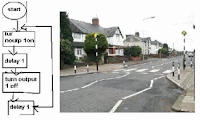 In an earlier posting I discussed how our year 6 students are using the Flowol control environment this term. We have spent the last few weeks building towards this by looking at and making flow diagrams to break familiar actions (procedures) down into smaller processes, to practice writing procedures in the format used to input to the software, before engaging with the real thing. We used Softease Studio to do this. The Object based Desk Top Publishing application within this suite, provides a diverse clipart gallery, which includes all the symbols necesary to create flow charts. Using this package we sketched out simple procedures for such things as watering the plants in the garden, getting ready for school, and crossing the road, establishing ideas about how these actions need to be carried out in particular orders if they are to be successful in meeting their purpose, and how potentially dangerous or even embarrasing it could be, if we did some things before others.
In an earlier posting I discussed how our year 6 students are using the Flowol control environment this term. We have spent the last few weeks building towards this by looking at and making flow diagrams to break familiar actions (procedures) down into smaller processes, to practice writing procedures in the format used to input to the software, before engaging with the real thing. We used Softease Studio to do this. The Object based Desk Top Publishing application within this suite, provides a diverse clipart gallery, which includes all the symbols necesary to create flow charts. Using this package we sketched out simple procedures for such things as watering the plants in the garden, getting ready for school, and crossing the road, establishing ideas about how these actions need to be carried out in particular orders if they are to be successful in meeting their purpose, and how potentially dangerous or even embarrasing it could be, if we did some things before others.Today we used Flowol for the first time. As an environment for control, flowol does not rely on a visible scripting language to bring about changes in outputs, but uses a flow diagram structure to input commands. For those of us who do not have, control boxes, the software also comes with tools called "mimics," on screen models which can be controlled from within the software. Today we began our quest by designing a procedure to control the lights at a model zebra crossing. The session began with a Smart Notebook, and a video I had made of a Zebra Crossing at work. Having watched the video we discussed what we had seen happening. The lights were flashing but what did flashing mean? What was changing? What needed to happen inside the yellow ball in order for a "flash" to happen as an output? Initially the students found it very difficult to articulate, and identify what was happening or needed to make the flash. We spent quite some time discussing this, drawing on their experiences in science, and helping them to make links with what we could see happening, and enabling them to understand that this flash was actually brought about by the turning on and then off a light bulb.
With this established, we moved to our notebook, in order to sequence the procedure, we might need to make the bulb flash. Start-> turn bulb on -> turn bulb off -> stop. With a little further discussion, and working through the procedure the students began to realise that this wouldn't actually achieve the repeated flash we needed, and that the bulb would go on once and off once before stopping. We needed to introduce a loop, into the procedure if the light was to go on and off repeatedly. I was then able to introduce the idea that their was a space in between each on and off, or in the terms used by our software environment a delay.
I introduced the now fairly familiar format for inputting procedures to the Flowol environment and how it worked, and the students were encouraged to use the two initial steps I had modelled, and the procedure we had written together in our smartbook to work in pairs to develop their own procedures to make the light flash. As the session proceeded and more and more children were successful in getting the model to work, we introduced editing procedures to change variables, eg could we write a procedure which kept the light on for longer than it was off? How quickly could they make the bulbs flash and so on. This in turn lead to reminders that their were smaller numbers than 1, and how could we record these, fraction inputs needed to be recorded in decimal notation. I was planning to write about this later, as working with this software is very new to me, but on visiting Think.com, our learning community tool I noticed that one of my students, had invited me to come and visit his Flowol Page. He had spent much of this evening, searching the web to find an image similar to the mimic we had been working on today, and using a graphics package he had inserted this, into a prepared flow chart, and saved it to upload to his think space. The image at the top of this article is his own work, in follow up to today's activity. If this is the response from today, can't wait until next week, when we will be using the same environment to sequence the light controls for a set of traffic lights. Watch this space.
No comments:
Post a Comment